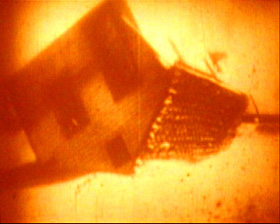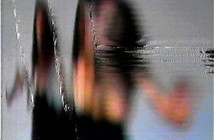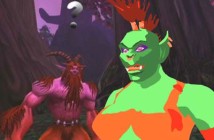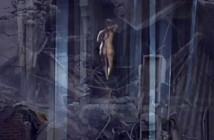As the only Boston representatives of the newly opened Whitney Biennial “Day for Night”, I thought it appropriate to give local filmmakers Louise Bourque and Joe Gibbons some much-deserved attention. I asked new Big RED & Shiny contributor Phaedra Shanbaum to give a synopsis of each of their practices for those unfamiliar to their work. Also, part 2 of this article will appear in issue #39, where regular contributor Christian Holland and myself will conduct an interview with each artist, paying special attention to the work that will be screened. Stay tuned and enjoy!
--
Boston has always been a hotbed for experimental, and alternative art. Specifically the film and video scene. From the 1960s on, programs such as BF/VF, The New Television Workshops, Center for Advanced Visual Studies at MIT, and The CAT fund at the Institute of Contemporary Art attracted artists working in film and video from around the world. Artists such as Nam June Paik, Bill Viola, and William Wegman created some of their most influential pieces while working in this city. So it comes as no surprise that the Whitney Biennial, which is commonly perceived as a survey of the best living contemporary artists working in the United States is, this year, screening the work of Massachusetts based film and video artists Louise Bourque and Joe Gibbons. Bourque and Gibbons have been an integral part of Boston’s art scene, specifically Gibbons, who has been a force in film and video in Boston dating back to the early 80s.
Bourque, a French Canadian filmmaker received her BFA from Concordia University in Montreal in film production and MFA from the school of the Art Institute of Chicago. Presently Bourque resides in Massachusetts, and has been teaching film in Boston since 1996. Her piece The Bleeding Heart of It (2005) was screened at the 2006 Sundance Film Festival. Her works have been presented in more than 35 different countries, broadcast on PBS, the Sundance Channel, and have been screened at the Whitney Museum and locally in venues such as the Photographic Resource Center.
Bourque considers herself a “film artist”, creating experimental work that centers around the exploration of psychological, societal, and women’s issues. She accomplishes these goals by utilizing and re-editing footage of old family home movies, as well as found film footage. In pieces such as Fissures, (1999) Going Back Home, (2000) and Imprint (1997) the film is toned, scratched, punched, warped, solarized, and generally marred. Along with this technique, Bourque often blurs, fades, and wipes her footage in and out. She combines this with soundtracks from old music box and phonographic recordings. These films provide the viewer with a snippet of a very private, and very worn recollection of time and space, adding to the feeling of a bad memory being pulled out of the subconscious. Other pieces such as The People in the House, (1994) and Jolicoeur Touriste (1989) are cleaner, and more traditionally cinematic in quality, and focus on issues of the family, gender roles and the woman’s place in the home, religion and in society. While some of the works are jerky, rough and dark, Bourque manages to delve into the unknown, creating an eerie, rhythmic narrative that draws the viewer into the world of memories she has created.
Gibbons started his video career in Boston and has been an important figure in the local art scene since. He was considered a leader within a local group of film and video artists which included Andrew Neumann, Bob Gibson, Saul Levine, Erika Beckman, Kathy Izzo, and Dana Moser, who were emerging in the mid-80s-early 90s. Gibbons early work was edgy and unique. Using a hand held Fisher Price children’s camcorder, which recorded onto a black and white audiotape, Gibbons developed a video style that was gritty, fictionally diaristic, dark, and neurotic. The fact that he and many other video artists at the time were using such “low” technology to create these works, directly contributed to a raw style he was looking for.
In his work, Gibbons, created a semi-fictional character “Joe”. “Joe” is a social malcontent who creepily explores and exploits gender roles while playing with dolls, Pretty Boy (1994), and Barbie’s Audition (1995)(this piece was selected to appear at Sundance Film Festival, and then vetoed due to the lack of Mattel’s permission of the dolls appearance.) In His Master’s Voice (1994), Sabotaging Spring, (1990) and Elegy, (1991) Gibbons rants directly into the camera, and generally insists on recording every word he says. He talks to his dog about subjects such as life, death, and the terrible acts the dog has made him perform.
Collaborating with video artist Tony Ousler, he created the two works On Our Own, (1989) and Toxic Detox (1992). Like much video art, these works drew their themes from social and political events that were occurring at the time, specifically the release of patients from the mental institutions across Massachusetts. The video consisted of “Joe” and “Tony”, two institutional patients who due to the political environment at the time, are evicted from the sanctuary of their institution, and are forced to become roommates in the real world.
In the nineties, Gibbons made the move from Boston to New York City where among other projects, he collaborated with Emily Breer on the feature length film The Genius (1993) staring performance artist Karen Finley. Gibbons has shown work in three previous biennials, 1995, 2000 and 2002. His work has been shown widely, most notably at MoMA, The ICA Boston, and The Black Maria Film and Video Festival in which he has won numerous awards. He is now back in Massachusetts where he teaches at MIT.
Gibbons will be showing three pieces:
* A Time to Die, 2005. Video, color, sound; 8 min. • Gibbons is an irascible hit man accosting autumnal flowers for hanging on to their beauty after their prime.
* Doppelganger Part 1, 2005. Video, color, sound; approx. 15 min. • Mining Freudian territory, the artist plays a man who believes he is being followed by his double.
Bourque will be showing two pieces:
* Jours en fleurs, 2003. 35mm film, color, sound; 4:30 min. • Reflecting on gestation and decay, Bourque transforms images of blossoms through menstrual blood.
* L’éclat du mal/The Bleeding Heart of It, 2005. 35mm film (widescreen),color, sound; 8 min. • Using deteriorated home movies shot by her father, Bourque casts an unsparing eye on unfulfilled promises and lost innocence.
Together with Tony Conrad:
* Tony Conrad with Joe Gibbons and Louise Bourque, TheProducer, 2005. Video, color, sound; 17 min. • Conrad stars as a suave Hollywood type; Bourque, Gibbons, and Buffalo’s Lenox Hotel appear in supporting roles.
Links:
Whitney Bienniel
"Day For Night: The 2006 Whitney Biennial" is on view from March 2, 2006 - May 28, 2006 at the Whitney Museum of American Art.
All images are courtesy of Joe Gibbons and Louise Bourque






